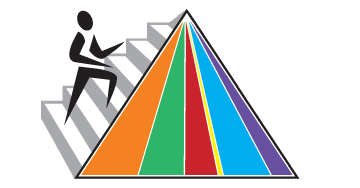Assume a pyramid with an altitude of x million dollars….
And that new food pyramid? The USDA has seriously outdone itself in purposeless bureaucratic condescension. Ann Althouse is justifiably irritated at the cutesy site title, but it’s the graphic that does it for me:

I had to laugh out loud at the irony. The rainbow is so dear to the hearts of I’m-okay-you’re-okay types as a way to say we’re all equally adorable, so it’s no surprise that it recommended itself to the tofu-worshippers at the USDA. But, of course, the whole point of this particular project is to push the value of whole grains while banishing trans-fats to outer darkness, so equal ROYGBIV bands would not have worked.
The site is pretty snazzy and easy to navigate, but it illustrates the problems with having federal programs for this sort of thing. Read the information and tips and you start to wonder very quickly just who the target audience is. Some samples:
- To eat more whole grains, substitute a whole-grain product for a refined product – such as eating whole-wheat bread instead of white bread or brown rice instead of white rice. It’s important to substitute the whole-grain product for the refined one, rather than adding the whole-grain product. (link)
- Freeze leftover cooked brown rice, bulgur, or barley. Heat and serve it later as a quick side dish. (link)
- Try different textures of fruits. For example, apples are crunchy, bananas are smooth and creamy, and oranges are juicy. (link)
- Cut-up fruit makes a great snack. Either cut them yourself, or buy pre-cut packages of fruit pieces like pineapples or melons. Or, try whole fresh berries or grapes. (link)
Most of the advice is like this, so I initially figured MyPyramid was the site geared toward children and that there was another, stuffier one elsewhere. But each page about the food groups (or food EMS bands or whatever they’re to be called now) also has a section at the bottom that’s explicitly directed at kids, and you can get calorie intake recommendations based on your age, so we grown-ups are clearly the main audience.
In other words, the USDA is looking at adults who don’t know what instead of means, don’t know that their freezer can be used to store leftover rice as well as Lean Cuisine dinners, don’t know that apples and bananas have different textures, and don’t know a whole lot of other perkily-explained things I’d drive myself into the madhouse by quoting. At least we’re still trusted to handle sharp knives.
None of this stuff is untrue, of course, and those of us who were taught to cook when we were little can fall into thinking that much of it is intuitive when it really isn’t. Why can’t you freeze a lot of vegetables without blanching them? Why should you add the salt at the beginning some times and at the end others? The thing is, despite all the blaring about the latest scientific information and the effort our trusty USDA folks have expended on compiling it, most of what’s on MyPyramid.gov isn’t anything you couldn’t learn from a collection of a half-dozen basic cookbooks and some Julia Child reruns. I do think the standardized nutrition label is a good idea; the Japanese have essentially adopted it, and it makes it easier to avoid foods that are half additives. But all of this huffing and puffing and throwing tax money around like confetti–just to tell us that fresh plant-based foods are healthy, in case we didn’t already hear it from Mom and the home ec teacher–is asinine.